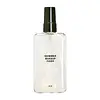What's inside
What's inside
 Key Ingredients
Key Ingredients

No key ingredients
 Benefits
Benefits

 Concerns
Concerns

 Ingredients Side-by-side
Ingredients Side-by-side

Water
Skin ConditioningDimethicone
EmollientButylene Glycol
HumectantPvp
Emulsion StabilisingTrimethylsiloxysilicate
EmollientPhenoxyethanol
PreservativeSilica
AbrasiveEthylhexylglycerin
Skin ConditioningPPG-26-Buteth-26
Skin ConditioningDisodium EDTA
Sodium Citrate
BufferingAlumina
AbrasiveParfum
MaskingPEG-40 Hydrogenated Castor Oil
EmulsifyingCitric Acid
BufferingPropanediol
SolventTin Oxide
AbrasiveMethylpropanediol
SolventSynthetic Fluorphlogopite
Brassica Campestris Seed Oil
Skin ConditioningUndaria Pinnatifida Extract
Skin ConditioningCeramide EOP
Skin ConditioningLactobacillus Ferment
Skin ConditioningGlycyrrhiza Glabra Root Extract
BleachingUlmus Davidiana Root Extract
Skin ConditioningSophora Flavescens Root Extract
AntioxidantChrysanthemum Zawadskii Extract
Skin ConditioningPerilla Frutescens Leaf Extract
MaskingAzadirachta Indica Leaf Extract
Skin ConditioningChrysanthemum Parthenium Extract
Skin ConditioningPentylene Glycol
Skin Conditioning1,2-Hexanediol
Skin ConditioningCaprylyl Glycol
EmollientCentella Asiatica Flower/Leaf/Stem Extract
Skin ConditioningHibiscus Mutabilis Flower Extract
Skin ConditioningCalendula Officinalis Flower Extract
MaskingChrysanthellum Indicum Extract
Skin ConditioningMagnolia Sieboldii Extract
Skin ConditioningCI 77891
Cosmetic ColorantCI 77491
Cosmetic ColorantWater, Dimethicone, Butylene Glycol, Pvp, Trimethylsiloxysilicate, Phenoxyethanol, Silica, Ethylhexylglycerin, PPG-26-Buteth-26, Disodium EDTA, Sodium Citrate, Alumina, Parfum, PEG-40 Hydrogenated Castor Oil, Citric Acid, Propanediol, Tin Oxide, Methylpropanediol, Synthetic Fluorphlogopite, Brassica Campestris Seed Oil, Undaria Pinnatifida Extract, Ceramide EOP, Lactobacillus Ferment, Glycyrrhiza Glabra Root Extract, Ulmus Davidiana Root Extract, Sophora Flavescens Root Extract, Chrysanthemum Zawadskii Extract, Perilla Frutescens Leaf Extract, Azadirachta Indica Leaf Extract, Chrysanthemum Parthenium Extract, Pentylene Glycol, 1,2-Hexanediol, Caprylyl Glycol, Centella Asiatica Flower/Leaf/Stem Extract, Hibiscus Mutabilis Flower Extract, Calendula Officinalis Flower Extract, Chrysanthellum Indicum Extract, Magnolia Sieboldii Extract, CI 77891, CI 77491
Ingredients Explained
These ingredients are found in both products.
Ingredients higher up in an ingredient list are typically present in a larger amount.
Butylene Glycol (or BG) is used within cosmetic products for a few different reasons:
Overall, Butylene Glycol is a safe and well-rounded ingredient that works well with other ingredients.
Though this ingredient works well with most skin types, some people with sensitive skin may experience a reaction such as allergic rashes, closed comedones, or itchiness.
Learn more about Butylene GlycolCi 77891 is a white pigment from Titanium dioxide. It is naturally found in minerals such as rutile and ilmenite.
It's main function is to add a white color to cosmetics. It can also be mixed with other colors to create different shades.
Ci 77891 is commonly found in sunscreens due to its ability to block UV rays.
Learn more about CI 77891Citric Acid is an alpha hydroxy acid (AHA) naturally found in citrus fruits like oranges, lemons, and limes.
Like other AHAs, citric acid can exfoliate skin by breaking down the bonds that hold dead skin cells together. This helps reveal smoother and brighter skin underneath.
However, this exfoliating effect only happens at high concentrations (20%) which can be hard to find in cosmetic products.
Due to this, citric acid is usually included in small amounts as a pH adjuster. This helps keep products slightly more acidic and compatible with skin's natural pH.
In skincare formulas, citric acid can:
While it can provide some skin benefits, research shows lactic acid and glycolic acid are generally more effective and less irritating exfoliants.
Most citric acid used in skincare today is made by fermenting sugars (usually from molasses). This synthetic version is identical to the natural citrus form but easier to stabilize and use in formulations.
Read more about some other popular AHA's here:
Learn more about Citric AcidPhenoxyethanol is a preservative that has germicide, antimicrobial, and aromatic properties. Studies show that phenoxyethanol can prevent microbial growth. By itself, it has a scent that is similar to that of a rose.
It's often used in formulations along with Caprylyl Glycol to preserve the shelf life of products.
Pvp is a water-soluble synthetic polymer and common hairstyling ingredient. It is a film-forming ingredient and used to "hold" specific shapes of hair.
Pvp is less effective in high-humidity. It tends to draw moisture, but this moisture dismantles the structure and "hold".
Sodium Citrate is the sodium salts of citric acid. In skincare, it is used to alter pH levels and acts as a preservative.
Its main functions are to maintain the pH of a product and neutralize metal ions.
The acidity of our skin is maintained by our glands and skin biome; normal pH level of skin is slightly acidic (~4.75-5.5).
Being slightly acidic allows our skin to create an "acid mantle". This acid mantle is a thin barrier that protects our skin from bacteria and contaminants.
Learn more about Sodium CitrateWater. It's the most common cosmetic ingredient of all. You'll usually see it at the top of ingredient lists, meaning that it makes up the largest part of the product.
So why is it so popular? Water most often acts as a solvent - this means that it helps dissolve other ingredients into the formulation.
You'll also recognize water as that liquid we all need to stay alive. If you see this, drink a glass of water. Stay hydrated!
Learn more about Water